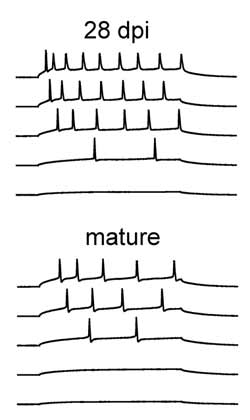![]() Some facts on neuronal excitability:
Some facts on neuronal excitability:
- Excitable: the ability to fire action potentials.
- More excitable: fires action potentials, but more.
- More LTP: not the same as more excitable.
- Less inhibition: also not the same as more excitable, though the two may go hand in hand.
- The Scholarpedia page on neuronal excitability, which was last modified on 13 August 2009, has been accessed 49,025 times, and contains no information (peer review is slow).
One of the claims that is often made is that adult-born neurons are more plastic and more excitable than older neurons. This despite there being little evidence (until recently) that new neurons indeed are more excitable. But, hey, “excitable” sounds great alongside “plastic”. The Schmidt-Hieber paper did show that new neurons are more excitable, though it wasn’t their main focus and it is only occasionally referenced as evidence for greater excitability.
My misunderstanding that there are no thorough investigations of new neuron excitability was brought to an end recently when I was fortunate to have an infant-free moment (In which I was able to read two papers in the same evening, plus an entire New Yorker article over breakfast. Amazing.) One of the papers was Reliable Activation of Immature Neurons in the Adult Hippocampus by Mongiat et al. from Alejandro Schinder’s lab, which I really should have read long ago.
Young neurons are spikier
In the introduction the authors note that for new neurons to have a function, they must be able to generate action potentials (aka fire action potentials, aka spike), the basic unit of activity and communication between neurons. The degree of excitability of a neuron – it’s ability to fire action potentials – is influenced by its shape, ion channels and the number of synapses that are stimulating it. Coincident activation of distinct inputs onto the same neuron can boost the chances of action potential firing and lead to the integration of different pieces of information. And the same neuron can represent different information depending on the frequency of its firing. So, a good characterization of excitability will be necessary to understand how adult-born neurons process information.
To do this the authors recorded from individual GFP+ granule neurons of various ages. The key findings:
- Smaller current injections were able to elicit comparable spiking in 24-29 day old neurons and mature neurons (see figure). 19 day old neurons were not very good at firing action potentials.
- Synaptic stimulation evoked action potentials similarly in young and mature neurons. What is significant though is that young neurons had fewer synapses, yet were equally capable of responding to a given stimulus. The amount of synaptic current required to depolarize young neurons, and bring them closer to firing an action potential, was about half that of mature neurons.
- young neuronal spiking was delayed and variable in response to synaptic stimulation, consistent with the possibility that their spikes could code information differently than mature neurons
- Relative to mature neurons, young neurons had almost normal voltage-gated Na+ and K+ currents, which are the primary currents involved in action potential generation. In contrast, they had much weaker inward-rectifying K+ currents (Kir), which are generated by K+ channels that are always open and therefore always steer the cell towards a hyperpolarized state where it will not fire action potentials. As the authors put it, there is an “ongoing homeostatic regulation that maintains a high degree of excitability in immature DGCs by boosting currents involved in spike generation while limiting the development of Kir currents.”
- When these Kir channels were blocked pharmacologically, mature neurons became like excitable young neurons. Furthermore, overexpressing Kir channels in young neurons made them less excitable, like mature neurons.
The take-home message to me seems to be that 3 to 4-week-old neurons, despite being rather immature, are fully capable of firing action potentials. They aren’t necessarily more active, but they are more excitable because they are more efficient at converting synaptic stimulation into firing behavior. Importantly, GABAergic inhibition was blocked for all of these experiments. Given that immature neurons have reduced inhibition they may be more likely to fire action potentials in the behaving animal or inhibited electrophysiology preparation. The other take-home message is that this group is great at consistently addressing physiological questions that are necessary for generating theories about how new neurons might contribute to circuit-level function and behavior.
Mongiat LA, Espósito MS, Lombardi G, & Schinder AF (2009). Reliable activation of immature neurons in the adult hippocampus. PloS one, 4 (4) PMID: 19399173

Pingback: Tweets that mention Are new neurons really more excitable? (yes) | Functional Neurogenesis -- Topsy.com
Love the blog.
If you haven’t seen it yet… recently came out in PNAS:
“Compensatory network changes in the dentate gyrus
restore long-term potentiation following ablation of
neurogenesis in young-adult mice”
Check out when you have more “infant-free” moments. Not earth-shattering but has some interesting implications for previous studies that base their learning results upon DG plasticity.
Pingback: Random Roundup | Functional Neurogenesis
Pingback: Enhanced integrative properties of immature neurons #sfn11 | Functional Neurogenesis